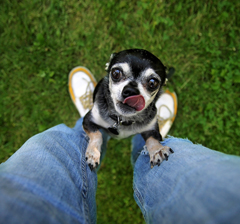Many dog owners see their pets as family members. That designation may be more appropriate than one would think. Extensive data now show that canine and human emotional behaviors are similar in many ways.
We’ve always known that dogs, similar to cats, love to make eye contact with people. But dogs also take in many other types of sensory information that helps them assess humans under their surveillance. A dog’s superior smell and hearing, for example, enable him to determine when his owner is upset – even before another human can.
Canine loyalty also has some dramatic effects on a dog’s behavior, as shown by a study reported in the August 2015 issue of Animal Behaviour. More than 50 dogs, in the presence of their owners, were observed as the owners struggled to get something out of a container. Actors participating in the study were asked by the owners to help them, and either provided assistance or refused to do so. When the helpers and non-helpers offered treats to the dogs afterward, the pets were less likely to accept treats from those who rebuffed their owners. In effect, the dogs’ loyalty to their owners superseded their own self-interest.

On a more technical level, magnetic resonance imaging (MRI) is helping us compare canine and human brain activity during certain behaviors. Dogs and humans have been found to use similar brain mechanisms to process social information and react to sounds associated with different emotional states. The structure and function of the caudate nucleus, for example, are strikingly similar in dogs and humans. Activation of this area of the brain can accurately predict preferences for food, music or even beauty. Does this mean dogs can appreciate a good tune or a lovely painting? Much more research is required to figure that out.
Ongoing study of canine brains may also help confirm whether dogs can feel empathy. Support for this possibility was demonstrated in a revealing study of dogs’ reactions to human despair, reported in the October 2014 issue of Behavioural Processes. Elevations of cortisol – a stress hormone – were found in both humans and dogs after they listened to the crying of a human infant. The dogs’ behavior indicated a combination of alertness and submissiveness, which could demonstrate concern about human suffering.

It’s not surprising that dogs earned a designation as man’s best friend. They’ve been valuable allies to humans since being domesticated thousands of years ago, and this friendship has become closer over centuries of evolution. Dogs’ long-time proximity to humans has put them in a good position to forge a deeper connection with their owners. This connection has been fostered by their role as working animals – everything from herders and retrievers to guards and Seeing Eye dogs. These jobs require dogs to pay close attention to their owners, and this attentiveness may help them learn how to detect subtle differences in the behaviors, and even feelings, of humans.
Meanwhile, technology is evolving to create new links between dogs and their owners. A system called iCPooch allows an owner to greet a dog remotely via a video screen, and dispense a treat while offsite. Perhaps scientists are also working on a tablet that dogs can use on their own. Let’s call it iPaw.

